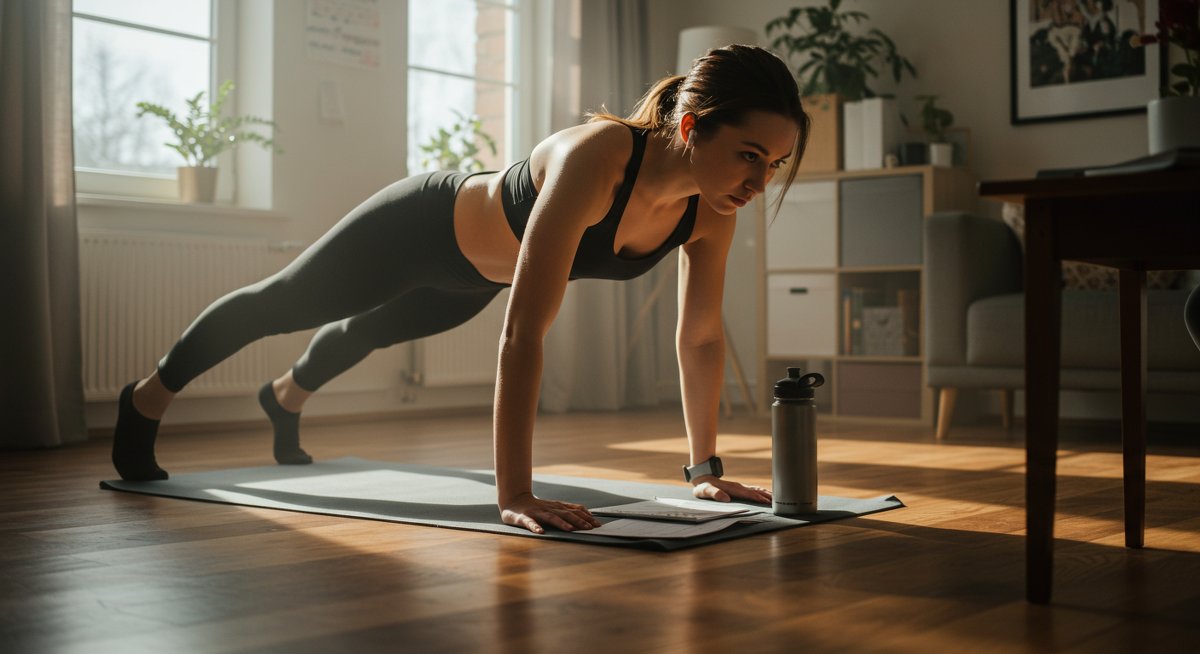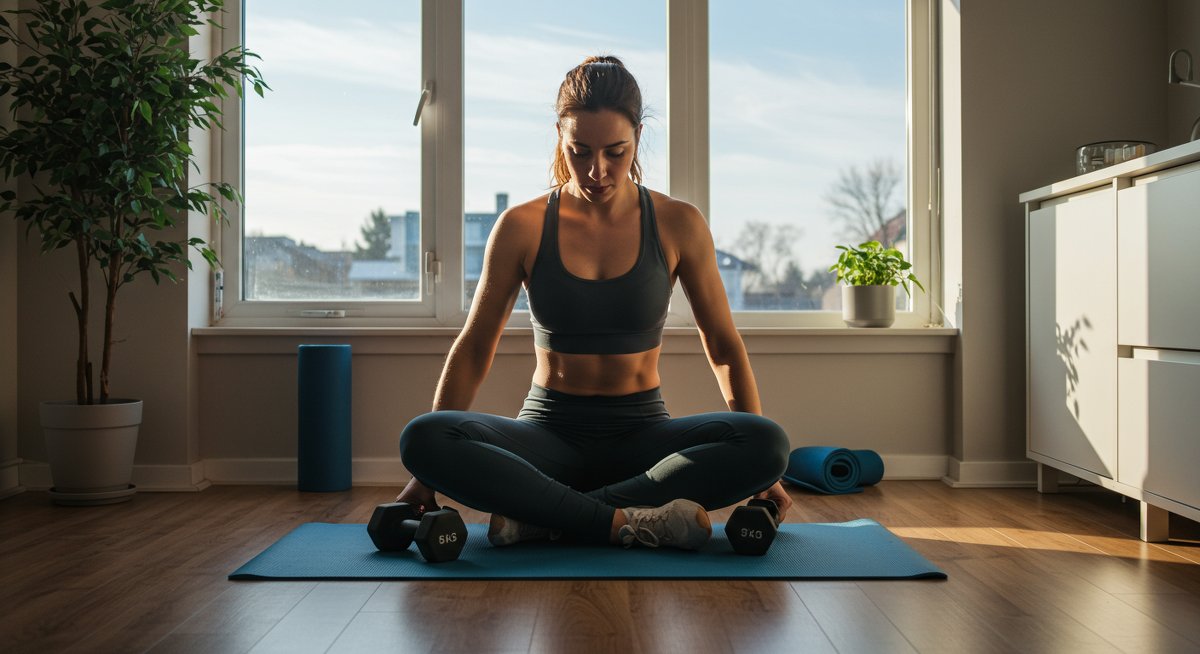Struggling to find time for the gym? Or maybe you start strong, only to fizzle out after a couple of weeks? You're not alone. Building a consistent home workout routine can be tough, but it's absolutely achievable. This article dives into 5 actionable strategies to help you build a fitness habit you'll actually enjoy, leading to real, sustainable results, even without a gym membership. We'll cover everything from understanding your motivation triggers to overcoming common obstacles and building a routine that fits seamlessly into your life, especially if you're a student with a busy schedule.

1. Understand Your 'Why' and Set Realistic Goals
Before you even think about planks and push-ups, take some time to clarify why you want to work out. What are your goals? Is it to boost your energy levels for those late-night study sessions? To reduce stress? Or maybe to feel more confident in your own skin? Knowing your 'why' is the foundation of any successful habit.
- Example 1: The Student's Dilemma. Imagine you're a student aiming to manage stress during exam season. Your 'why' might be to alleviate anxiety and improve focus. Setting realistic goals could look like committing to 15-20 minutes of exercise, three times a week. This is a far cry from the pressure of an hour-long workout every day, making it easier to stick to your plan.
- Example 2: The Busy Professional. You're juggling a full-time job and a demanding social life. Your 'why' is to maintain overall health and boost energy levels. Setting realistic goals would involve scheduling quick workouts during your lunch break or after work. Starting with two 20-minute sessions a week can be more sustainable than aiming for five hour-long sessions.
- Example 3: The Remote Worker. As a remote worker, you might struggle with prolonged sitting and a lack of activity. Your 'why' is to combat a sedentary lifestyle and improve your posture. A realistic goal might involve incorporating short, regular movement breaks throughout the day, like a quick stretch every hour, and aiming for a 15-minute workout three times a week.
Common Mistakes: Setting unrealistic goals (e.g., working out daily for an hour when you have a packed schedule) or not defining your 'why' clearly. This can lead to feeling overwhelmed and eventually, abandoning your workout plan.
Expert Tip: Write down your 'why' and your goals. Place this list where you'll see it every day – on your desk, your bathroom mirror, or even as your phone's lock screen. This visual reminder keeps you focused and motivated.
Benefits and How It Helps Your Goals: Clear goals provide motivation, improve focus, reduce procrastination, and lead to a sustainable habit. Starting small allows for building momentum and celebrating wins along the way.
2. Schedule It Like a Class (and Stick to It!)
Treating your workouts like important appointments is a game-changer. Block out specific times in your day or week for exercise, just like you would for a class or meeting. This creates a sense of commitment and prevents you from constantly rescheduling or skipping sessions.
- Example 1: The Morning Routine. Schedule a 20-minute bodyweight workout before you start your classes. Even if you only have 30 minutes, the workout will give you a quick boost. Setting the alarm, and laying out your workout clothes the night before makes it easier to get started.
- Example 2: The Lunch Break Blitz. If you have a flexible lunch break, dedicate half of it to a quick workout. This is a great way to break up the day, clear your head, and recharge for the afternoon. Many students have a 1-hour lunch break, so this works well for them.
- Example 3: The Evening Wind-Down. Schedule your workout after classes or work, but before you start winding down for the evening. This can help you de-stress and improve sleep quality. Make sure you are flexible with your time, as you will want to plan your workout around your busy schedule.
Common Mistakes: Not scheduling your workouts, or treating them as optional. This leads to easily skipping them due to other commitments.
Expert Tip: Use a calendar or planner (digital or physical) to schedule your workouts. Set reminders on your phone to prevent procrastination. Consider using habit-tracking apps to stay accountable and see your progress.
Benefits and How It Helps Your Goals: Regular scheduling helps build consistency, increases accountability, and makes workouts a non-negotiable part of your routine.

3. Create a Dedicated Workout Space
Having a designated workout area, even if it's just a corner of your room, can significantly improve your workout consistency. This space should be free from distractions and conducive to exercise. When you enter this area, you're mentally signaling your body that it's time to work out.
- Example 1: Dorm Room Transformation. In a small dorm room, clear a space near a wall. Invest in a yoga mat. Store all your workout gear (resistance bands, light weights, etc.) in a bin that can easily be moved out of the way after your workout. Ensure your workout space has good lighting and access to a power outlet for your phone or music.
- Example 2: Living Room Setup. If you live in a shared apartment, dedicate a corner of your living room for your workouts. Place a yoga mat, a small set of dumbbells, and a portable Bluetooth speaker for music. Ensure your space is free of clutter and distractions (like the TV) during your workout sessions.
- Example 3: Home Office Integration. If you work from home, make sure you have a workout space. You can use your workspace, or set up a dedicated spot in the corner. Keep a set of dumbbells, resistance bands, and a yoga mat close by so it's easier to slip into a routine.
Common Mistakes: Working out in a cluttered or distracting environment, or in a place where you're easily interrupted.
Expert Tip: Decorate your workout space with inspiring visuals, such as motivational posters, pictures, or a vision board. This helps create a positive and motivating atmosphere. Invest in a comfortable yoga mat for floor exercises and stretches.
Benefits and How It Helps Your Goals: A dedicated space signals to your brain that it's workout time, reducing distractions and increasing your focus and motivation.
4. Embrace No-Equipment Workouts and Short Bursts
One of the biggest barriers to home workouts is the perceived need for equipment. Thankfully, you don't need a gym or expensive gear to get a great workout. Bodyweight exercises are incredibly effective and accessible.
- Example 1: The 20-Minute Power Session. Designate a workout that will engage all of your muscles. Include exercises like squats, push-ups, lunges, planks, and burpees. Perform each exercise for 45 seconds, with 15 seconds of rest in between. This type of workout fits perfectly into a busy schedule, offering significant benefits in a short time.
- Example 2: The Micro-Workout Approach. If you struggle to find long blocks of time, break your workout into shorter, more frequent sessions. Do 10 minutes of exercise in the morning and another 10 minutes in the evening. Include exercises like jumping jacks, high knees, and mountain climbers. This can be done even during a study break.
- Example 3: The Study Break Routine. Schedule three sets of five exercises. Squats, push-ups, and lunges. Each set would be 30 seconds with a 15-second break. Repeat three times, for an effective workout in under 10 minutes. This works well for students studying at home.
Common Mistakes: Thinking you need expensive equipment or long blocks of time to get a good workout.
Expert Tip: Explore online resources like YouTube, which offer a wealth of free, no-equipment workout routines. Many fitness apps also provide structured, bodyweight workouts that can be easily followed at home. Aim to incorporate a variety of exercises to work all major muscle groups.
Benefits and How It Helps Your Goals: Removes the need for travel time and specialized equipment, making it easier to fit workouts into your schedule. Short bursts are less intimidating and more sustainable.
5. Track Your Progress and Celebrate Small Wins
Tracking your progress provides motivation and helps you stay on track. Seeing tangible improvements – even small ones – is incredibly rewarding and encourages you to continue. This could be as simple as noting how many push-ups you can do, how long you can hold a plank, or how many workouts you completed each week.
- Example 1: The Habit-Tracking App. Use a habit-tracking app to log your workouts. Mark each completed workout to see your progress over time. This will make it visible how often you're working out, and keep you accountable. Many apps offer visual charts and graphs to show your progress.
- Example 2: The Fitness Journal. Get a notebook specifically for your workouts. Track the exercises you do, the sets and reps, and any notes on how you felt. You can also record your weight and measurements weekly or monthly. This is a great way to reflect on your progress.
- Example 3: The Social Media Share. If you are comfortable with it, share your progress on social media. This can provide external motivation and accountability, especially if you have friends or family who also work out. You can post updates on your workouts, or simply log how often you work out.
Common Mistakes: Not tracking progress, or focusing only on the big picture. This leads to not noticing small changes and can make you feel like you're not making progress.
Expert Tip: Celebrate your milestones, no matter how small. Reward yourself for sticking to your workout routine – whether it's a relaxing bath, watching your favorite show, or buying a new workout outfit. This reinforces positive behavior and keeps you motivated.
Benefits and How It Helps Your Goals: Tracking progress provides motivation, boosts confidence, and helps you see the results of your hard work, making your goals more attainable.
Next Steps in Your Home Fitness Journey
Building a consistent home workout routine is a journey, not a destination. Remember to be patient, persistent, and kind to yourself. There will be days when you miss a workout, but don't let that derail your progress. Get back on track as soon as possible, and keep focusing on the strategies outlined above. By understanding your 'why', scheduling your workouts, creating a dedicated space, embracing no-equipment exercises, and tracking your progress, you can build a fitness habit that lasts a lifetime.